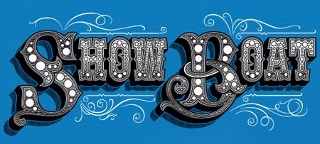SHOW BOAT JUST KEEPS ROLLING ALONG
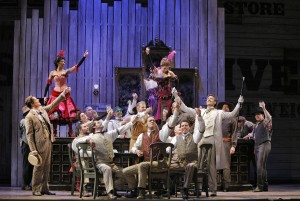 At San Francisco Opera’s summer company premiere of Show Boat, the first image at the War Memorial Opera House is a proscenium-high curtain depicting an enlarged expressionistic image of a steamer’s paddle wheel and two narrow, black smoke stacks. There’s an alluring monumentality to the image, and the solid, dusky tones create a somber mood, displacing any sense of gaiety. It very much reflects the drama ahead. Certainly there are laughs aplenty, but this monumental musical production is heartfelt enough to have elicited tears from an appreciative audience on opening night. Simply put, Show Boat is great theatre.
At San Francisco Opera’s summer company premiere of Show Boat, the first image at the War Memorial Opera House is a proscenium-high curtain depicting an enlarged expressionistic image of a steamer’s paddle wheel and two narrow, black smoke stacks. There’s an alluring monumentality to the image, and the solid, dusky tones create a somber mood, displacing any sense of gaiety. It very much reflects the drama ahead. Certainly there are laughs aplenty, but this monumental musical production is heartfelt enough to have elicited tears from an appreciative audience on opening night. Simply put, Show Boat is great theatre.
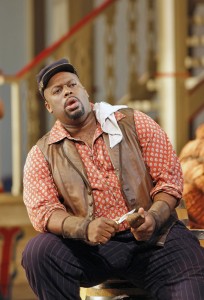 In this exhilarating presentation (first seen in 2012 at the Lyric Opera of Chicago followed by Houston Grand Opera and Washington National Opera), director Francesca Zambello’s lucid and balanced mega-theatrical approach works splendidly to create both unforgettable entertainment and poignant drama. The story, based on author Edna Ferber’s own observations of life on the floating theaters that plied U.S. rivers from the 1870s to the 1930s, portrays three generations of unsteady relationships aboard a Mississippi show boat, intertwined with the prejudices experienced by African-Americans. Ferber’s 1926 novel of the same name was an instant success, immediately becoming fodder for composer Jerome Kern and lyricist Oscar Hammerstein, whose theatrical adaptation premiered in New York in December, 1927. As with the novel, its success was instantaneous; despite this, many revisions on stage and in film, made by the authors and others, have occurred throughout its long performance history.
In this exhilarating presentation (first seen in 2012 at the Lyric Opera of Chicago followed by Houston Grand Opera and Washington National Opera), director Francesca Zambello’s lucid and balanced mega-theatrical approach works splendidly to create both unforgettable entertainment and poignant drama. The story, based on author Edna Ferber’s own observations of life on the floating theaters that plied U.S. rivers from the 1870s to the 1930s, portrays three generations of unsteady relationships aboard a Mississippi show boat, intertwined with the prejudices experienced by African-Americans. Ferber’s 1926 novel of the same name was an instant success, immediately becoming fodder for composer Jerome Kern and lyricist Oscar Hammerstein, whose theatrical adaptation premiered in New York in December, 1927. As with the novel, its success was instantaneous; despite this, many revisions on stage and in film, made by the authors and others, have occurred throughout its long performance history.
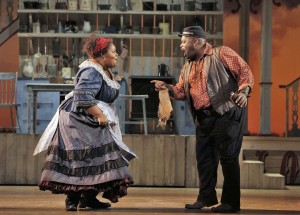 Except for some numbers which Robert Russell Bennett modified from his original scoring for the major 1946 revival, this production uses the 1927 orchestrations. Conductor John DeMain initiates the proceedings with vigor, keeping the score rolling smoothly along without shifting into unwelcome melodramatic fuss. The sound is tight and crisp, with all sections of the San Francisco Opera Orchestra providing balance and pizzazz to Kern’s thrilling union of varying musical styles.
Except for some numbers which Robert Russell Bennett modified from his original scoring for the major 1946 revival, this production uses the 1927 orchestrations. Conductor John DeMain initiates the proceedings with vigor, keeping the score rolling smoothly along without shifting into unwelcome melodramatic fuss. The sound is tight and crisp, with all sections of the San Francisco Opera Orchestra providing balance and pizzazz to Kern’s thrilling union of varying musical styles.
 Peter Davison’s stylized, colorful, period sets are numerous, varying from the voluminous to the intimate. The actual show boat initially disappoints: A cut-off, triple-height, curved, white-balustrade “stern” atop a flat stage surface appears more like a grandiose gazebo than a floating theater. That said, the transformations it undergoes do settle nicely for the stage action. Together with Paul Tazewell’s mass of costumes, which fittingly exude the brightness of jollity, the grittiness of hardship, and the passing of time, and Mark McCullough’s ornamental lighting design, the overall effect is indeed scintillating.
Peter Davison’s stylized, colorful, period sets are numerous, varying from the voluminous to the intimate. The actual show boat initially disappoints: A cut-off, triple-height, curved, white-balustrade “stern” atop a flat stage surface appears more like a grandiose gazebo than a floating theater. That said, the transformations it undergoes do settle nicely for the stage action. Together with Paul Tazewell’s mass of costumes, which fittingly exude the brightness of jollity, the grittiness of hardship, and the passing of time, and Mark McCullough’s ornamental lighting design, the overall effect is indeed scintillating.
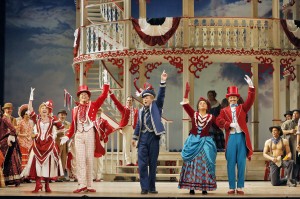 Alongside a mostly well-rehearsed chorus, the large cast of principals drawn from both opera and musical theater offer mixed performances. Although excessive acting seems de rigueur in the opera world, it’s actually entertaining and endearing here. Vocal accuracy occasionally strays, and the bouncy, rhythmical, syncopated score besets many of the principals’ timing and phrasing of the lyrics, but the overall mix of vocal depth and wonderfully integrated dramatic performances work their wonder to give tons of enjoyment.
Alongside a mostly well-rehearsed chorus, the large cast of principals drawn from both opera and musical theater offer mixed performances. Although excessive acting seems de rigueur in the opera world, it’s actually entertaining and endearing here. Vocal accuracy occasionally strays, and the bouncy, rhythmical, syncopated score besets many of the principals’ timing and phrasing of the lyrics, but the overall mix of vocal depth and wonderfully integrated dramatic performances work their wonder to give tons of enjoyment.
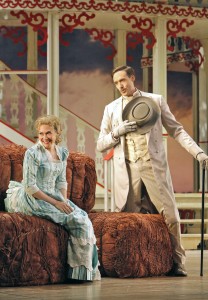 Bill Irwin is eccentric, lively and lithe as, perhaps, his own alter ego, Cap’n Andy Hawks, the show boat impresario. From camp to kooky, Irwin’s stage antics are a marvelous and unforgettable show in their own right. Heidi Sober as his daughter, Magnolia, journeys effortlessly from youthful naïveté to womanhood with radiance, especially so as a Broadway star in her rendition of “Dance Away the Night.”
Bill Irwin is eccentric, lively and lithe as, perhaps, his own alter ego, Cap’n Andy Hawks, the show boat impresario. From camp to kooky, Irwin’s stage antics are a marvelous and unforgettable show in their own right. Heidi Sober as his daughter, Magnolia, journeys effortlessly from youthful naïveté to womanhood with radiance, especially so as a Broadway star in her rendition of “Dance Away the Night.”
Looking suave as the “no-account” gambler and Magnolia’s enduring love, Gaylord Ravenal, Michael Todd Simpson swaggers with charm and a pulsating, baritone warmth. Patricia Racette is Julie La Verne, the 1887 show boat leading lady whose blissful life is shattered after her mixed-blood origins are reported to the authorities. Racette personifies the theatrical star she portrays and outshines all else in two of the musical’s big hits, “Can’t Help Lovin’ Dat Man” and “Bill,” delivering both with whipping wholehearted force.
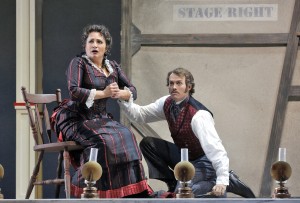 Kirsten Wyatt exudes cheeky exuberance as the ever-optimistic Ellie Mae Chipley, her captivating voice and wildly amusing dance moves proving a winning combination in “Life Upon the Wicked Stage.” As Frank Schultz, her loyal sidekick and later hubby, John Bolton grows with confidence to make a solid impact. Harriet Harris is delightfully crabby and interfering as Parthy Ann Hawks, Cap’n Andy’s wife. As the black show boat cook, Queenie, Angela Renée Simpson’s spot-on action and dialogue is mismatched by a honey-sweet voice unbefitting her strident character. The dazzling troupe of twelve dancers, who look like they hardly work up a sweat, entertain magnificently with action-packed routines, gorgeously choreographed by Michele Lynch.
Kirsten Wyatt exudes cheeky exuberance as the ever-optimistic Ellie Mae Chipley, her captivating voice and wildly amusing dance moves proving a winning combination in “Life Upon the Wicked Stage.” As Frank Schultz, her loyal sidekick and later hubby, John Bolton grows with confidence to make a solid impact. Harriet Harris is delightfully crabby and interfering as Parthy Ann Hawks, Cap’n Andy’s wife. As the black show boat cook, Queenie, Angela Renée Simpson’s spot-on action and dialogue is mismatched by a honey-sweet voice unbefitting her strident character. The dazzling troupe of twelve dancers, who look like they hardly work up a sweat, entertain magnificently with action-packed routines, gorgeously choreographed by Michele Lynch.
And finally, binding all the events and ever-changing moods over the story’s 40-year journey is Queenie’s husband, Joe. Morris Robinson bellows Show 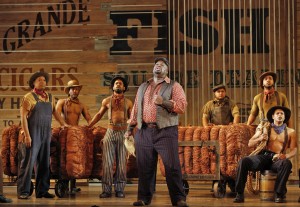 Boat’s underlying melancholic musical signature, “Ol’ Man River,” in a deep, cavernous, languid voice so monumental in form that it expresses time itself, evoking compassion and sympathy from the viewer.
Boat’s underlying melancholic musical signature, “Ol’ Man River,” in a deep, cavernous, languid voice so monumental in form that it expresses time itself, evoking compassion and sympathy from the viewer.
Conveying four decades, three theatre hours pass too quickly, leaving an underlying magical feeling that warrants singing aloud “Can’t Help Lovin’ Dat Show.” You may seriously consider seeing this ground-breaking work’”not quite musical, not exactly operetta’”again and again.
photos © Cory Weaver/San Francisco Opera
Show Boat
San Francisco Opera
co-production with Lyric Opera of Chicago,
Washington National Opera and Houston Grand Opera
War Memorial Opera House, 301 Van Ness Avenue
scheduled to end on July 2, 2014
2 hours and 45 minutes, including one intermission
sung in English with English supertitles
for tickets, call (415) 864-3330 or visit www.SFOpera.com
